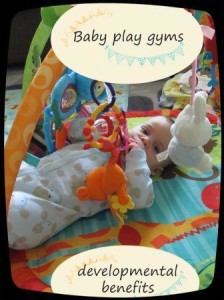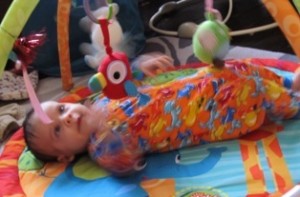I wanted to include things like play gyms and other apparatus, but wasn’t sure what category to put them under! I suppose they could come under sensory play, but also involve motor skills and creative play, to name a few. So here are some miscellaneous play elements:
— Play Gyms —
I was fortunate to be given a play gym from a friend with a one year old who had two play gyms and didn’t need one any more. She also didn’t want it back because they had a lot of baby stuff, so that was very nice. I don’t know if I would have bought one, or maybe I would have bought one a lot later and I think I would have really missed out. I got it when the Little Lovely (LL) was probably only a couple of months old and I have to say it’s been a GREAT piece of equipment. We hang lots of different toys from it, and alternate the toys. At 5 months he can usually knock or pull most of the toys down, but still seems to enjoy it. At earlier stages he was just lightly batting at toys in an uncoordinated manner, then grabbing, then grabbing with both hands, then trying to stuff them in his mouth. I really hope it’s aided his development in terms of sight, motor skills, been FUN and also importantly, for me, occupied him for a little while meaning that I could go do stuff like eat my breakfast!! (Something that was not possible for the first few weeks, or longer).
Our gym now has lots of stuff attached to it. It wasn’t always so complicated looking and we started with just one or two hanging toys that jingled when they moved.
From doing some brief research, gyms do indeed have developmental benefits: here is an article by “Mama OT” (a paediatric occupational therapist) on the Developmental Benefits of Using a Baby Play Gym. The article outlines some of the cognitive, visual perception, grasping and reaching skills, gross motor skills, self-awareness and sensory stimulation benefits of play gyms.
What I found of particular interest in the article was about gyms facilitating baby’s skills in bringing their two hands together at the midline of their body, such as while holding or reaching for a toy on the gym and therefore reaching across the midline of their body. Think of the midline as an invisible vertical line that runs down the middle of the body. Crossing the midline would involve touching one side of your body with the other, for example when you scratch your left ear with your right hand. I remember the occupational therapist that ran the baby massage classes I went to with LL talking about this and some of the exercises we did where LL “crossed the midline” by touching his left hand to his right foot and vice versa while singing a little song about a cheeky monkey.
The article writes that crossing the midline activity strengthens the Corpus Callosum (structure in middle of the brain involved in communication between left and right hemispheres), and is significant in learning to crawl and development of bilateral skills (using both sides of the body at the same time, e.g. using both hands together). Of course, other activities also help baby practice crossing the midline, like play and activities that we picked up at baby massage. Here’s a link to further information on crossing the midline with children.




Pingback: How to play with a newborn baby (0-3 months) – what and why – psychology and research | Easy Baby
Pingback: How to play with a newborn baby (0-3 months) – what and why – psychology and research | Baby Brain